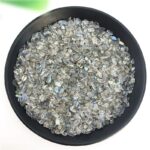Diamonds, renowned for their exceptional clarity and brilliance, have captivated hearts and adorned jewelry for centuries. These precious gemstones are composed of pure carbon atoms arranged in a three-dimensional lattice structure, giving them their unmatched hardness and transparency. The term “diamond” originates from the Greek word “adamas,” meaning “unbreakable,” reflecting the stone’s legendary durability.

Pain Points and Motivations:
Diamond enthusiasts often seek stones with the highest possible clarity, as it enhances the gemstone’s brilliance and overall beauty. The clarity of a diamond is determined by the presence or absence of inclusions, which are tiny imperfections or flaws within the stone. Inclusions can range from microscopic to visible, and their size, type, and location can affect the diamond’s value and appearance.
Effective Strategies:
Jewelers and diamond enthusiasts use various strategies to evaluate and grade the clarity of diamonds. The Gemological Institute of America (GIA) developed a standardized clarity grading system, which assigns a grade based on the number, size, and visibility of inclusions under 10x magnification. The clarity grades range from “Flawless” (FL) to “Included” (I1, I2, and I3), with “Internally Flawless” (IF) indicating stones with no visible inclusions.
Applications:
Beyond their use in jewelry, diamonds’ exceptional clarity and optical properties have found applications in various industries. In manufacturing, diamonds are employed in high-precision cutting tools due to their extreme hardness and wear resistance. In science, diamonds serve as essential components in lasers and other optical instruments, where their clarity allows for efficient light transmission and minimal distortion.
Aquamarine: The Tranquil Embrace of the Sea
Aquamarine, named after the Latin phrase for “seawater,” embodies the serene depths of the ocean with its ethereal blue hues. This captivating gemstone belongs to the beryl mineral family and primarily comprises aluminum silicate with trace amounts of iron, which impart its characteristic blue color. Aquamarine’s clarity ranges from transparent to translucent, revealing its enchanting depths and internal shimmer.
Pain Points and Motivations:
Aquamarine enthusiasts seek stones with a pure, vibrant blue color and exceptional clarity to showcase the gemstone’s beauty and calming energy. The presence of inclusions or cloudiness can detract from the stone’s desirability and value.
Effective Strategies:
Gemologists assess Aquamarine clarity by examining the stone’s transparency and the presence of visible inclusions. Clarity grades range from “Eye Clean” (EC) to “Included” (I1, I2, and I3), with “Eye Clean” indicating stones that appear free of inclusions to the naked eye.
Applications:
Aquamarine’s calming energy and association with water have led to its use in various wellness and spiritual practices. It is believed to promote emotional balance, tranquility, and inner peace. Aquamarine’s clarity enhances its therapeutic properties, allowing its soothing vibrations to penetrate the mind and body.
Topaz: The Timeless Treasure of Clarity
Topaz, a captivating gemstone known for its exceptional clarity and durability, has adorned crowns and inspired legends throughout history. Composed of aluminum silicate with traces of fluorine and hydroxyl, Topaz exhibits a wide range of hues, from colorless to vibrant shades of blue, yellow, orange, and pink. Its clarity can vary from transparent to translucent, showcasing its internal brilliance.
Pain Points and Motivations:
Topaz enthusiasts seek stones with pristine clarity to maximize their brilliance and showcase their captivating colors. Inclusions or cloudiness can diminish the stone’s beauty and value, especially in highly transparent varieties.
Effective Strategies:
Topaz clarity is evaluated based on the presence or absence of visible inclusions and the stone’s transparency. Clarity grades range from “Eye Clean” (EC) to “Included” (I1, I2, and I3), with “Eye Clean” indicating stones that appear free of inclusions to the naked eye.
Applications:
Topaz’s durability and clarity make it an ideal choice for jewelry, both as gemstones and decorative accents. Its high refractive index contributes to its exceptional sparkle and brilliance, making it a popular choice for earrings, pendants, and rings. Topaz’s clarity allows for intricate carvings and engravings, adding an artistic touch to jewelry designs.
White Sapphire: The Icy Radiance of Purity
White Sapphire, a member of the corundum mineral family, embodies the purity and brilliance of ice. Composed primarily of aluminum oxide, White Sapphire lacks the trace elements that impart color to other sapphires, resulting in its colorless appearance. Its clarity can range from transparent to translucent, showcasing its pristine depths and shimmering brilliance.
Pain Points and Motivations:
White Sapphire enthusiasts seek stones with exceptional clarity to maximize their brilliance and mimic the appearance of diamonds. Inclusions or cloudiness can detract from the stone’s icy radiance and diminish its value.
Effective Strategies:
White Sapphire clarity is assessed based on the presence of visible inclusions and the stone’s transparency. Clarity grades range from “Eye Clean” (EC) to “Included” (I1, I2, and I3), with “Eye Clean” indicating stones that appear free of inclusions to the naked eye.
Applications:
White Sapphire’s exceptional clarity and affordability make it a versatile choice for jewelry. Its icy brilliance complements various metals and gemstones, making it a popular choice for engagement rings, wedding bands, and anniversary gifts. White Sapphire’s durability and scratch resistance ensure its longevity in everyday wear.




























